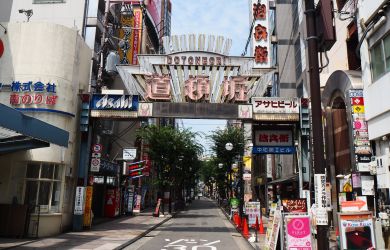
February 15, 2019
Jun Nakamura: Shibori and Contemporary Fashion
London-based Japanese designer reinterprets the art of shibori for the 21st century
By Paul McInnes
Metropolis was fortunate enough to meet with Jun Nakamura — a fashion designer based in London who works with the ancient art of shibori, which originates from one of three types of ancient Japanese resist-dyed techniques named kokechi. The process of shibori produces beautiful and intriguing patterns on fabric. A graduate of Osaka Mode Gakuen and currently studying for an MA in Fashion Design Womenswear at Istituto Marangoni London, Nakamura uses his familial background in kimono making and a thirst for contemporary design to create groundbreaking artisanal fashion.
Metropolis: After graduating from Osaka Mode Gakuen, which designers did you work with in Tokyo? What did you learn from them?
Jun Nakamura: I worked with some designers. A company I worked for specialises in handiwork, such as hand-woven fabrics and hand embroidery. I had the opportunity to visit India for research and to see factories. It was a good experience to see the handiwork process and talk to domestic workers. I also learnt how each designer developed their designs from inspirations.

M: You’ve said that the art of shibori is decreasing. Kimono manufacturing too. Why is this and is there a way that the Japanese government or cultural agencies can reverse this trend?
JN: The biggest reason is that the demand for kimono has been decreasing. This has been a long-standing trend. For example, we used to prepare a set of kimono for a wife before her marriage. Although there are families who still follow the traditional custom, this was already becoming less popular when I was in the kimono industry. Customers were often concerned that there were not many opportunities for them to wear kimono and they didn’t know how to wear it. In interviews, some specialists in the shibori industry also suggested to me that they have an issue of aging artisans too. In order to survive, they also produce innovative goods but this [practice] has just been started.
I think there could be some [ways the government or agencies can help] other than financial support. Offering more opportunities to learn about the tradition, including workshops at schools, exhibiting at popular places and encouraging collaborations with other industries could be considered, in my opinion. I think it isn’t really easy to reverse [the trend] and it would take very long, but I believe continuous engagement and efforts will lead to increasing popularity.
M: How can younger Japanese find a way to incorporate wearing kimono, yukata, jinbei and hanten into everyday life? I’m Scottish and the kilt used to be worn only for formal events but recently more Scottish people wear the kilt casually with jackets and sweaters.
JN: Like you said, including one item into daily styles of western clothing sounds like a very good option and seems easy to do. Jinbei, hanten and haori should be easy to integrate, like knit cardigans. However, kimono and yukata are very long and that might make it more difficult to coordinate. As those items have unique shapes, shortening the length or any ideas of changing length — by fastening or tying — would be necessary.

M: Do you think Japanese are losing their cultural identity? Why?
JN: Yes, I do. This is a very big topic and I don’t have the whole picture, but I think one thing is the progress of technology. I feel that Japanese generally like new technologies and the “latest things” more than people in other countries do. The more we are interested in upcoming apps and functions, the more we may be losing our attention to our culture. Also, communities have been losing functions. It was once common to bring up and educate children together with neighbours, but now many families are more isolated each other now. In addition, many new buildings have been constructed but most of them don’t have traditional features. I feel we tend to focus on functions here too. For me it’s important to leave some traditional appearances, so that we can feel our cultural heritage much closer.
M: In a recent article you said that sustainability is important for you. Repurposing used garments could “reduce the throwaway culture which is prevalent in the UK market.” Could you expand on this for me?
JN: The great amount of clothing being sent to landfills is one of the biggest environmental issues [today]. As these clothes decompose they release methane, and the chemicals on the clothes contaminate soil. The amount of recycled material has increased, but too many garments are still being sent to a landfill. There are some brands which create garments from second-hand clothing, but I guess this isn’t something every designer and brand can do. There will be differences in styles, colors and designs among different brands’ items.
Therefore, my idea is to develop a system in which customers drop off garments to a store or a brand where they shopped — the brand then repurposes those garments into new collections. As these are originally from their older seasons, I think it isn’t too difficult to include and reuse the material. Transportation is something to be considered — but brands could essentially gather materials for free.
M: Do you think the rise of fast fashion has had a detrimental effect on fashion as a whole?
JN: Yes, I do. Partly because people can buy more clothes for the same price, we tend not to think enough about whether the clothes will suit us or not, or are necessary or not. As a result, many people buy unnecessary garments and throw them away quickly. Particularly in Japan, the fast fashion trend has made brands and people alike obsessive about “catching” the trend as fast as possible, with the quality of the pieces being a low priority. It’s good to be able to buy a piece for a low price and to be able to coordinate your outfits easily. However, these careless cycles have caused negative effects in total.

M: Why did you decide to move to London? Is it easier to think about traditional Japanese clothing from the outside? Will you ever return to live in Japan?
JN: It was mainly because of my interest in brushing up on my skill-set and looking for more opportunities abroad as a designer. However, I also thought that introducing traditional techniques abroad may catch more attention than in Japan — then, the popularity garnered abroad might lead to traditional techniques being better valued in Japan. I didn’t actually think of using handicrafts in an innovative way back in Japan. I just thought that even though I used those techniques (and those were new for fashion), people might not be attracted that much, because those aesthetics are familiar to Japanese to some extent.
I would like to develop my career here more now. However, in the future it would be great to go back to the country which I am from.
M: Designers such as Jotaro Saito have been rethinking the idea of kimono and yukata for years, using material such as denim and unorthodox designs. What do you think of this?
JN: I think it’s a very interesting practice. Kimono has not changed its style for a long time. This is not only about kimono, but in Japan, there is a culture of maintaining common rules. I think this is changing slowly, though changes and uniqueness sometimes used to be considered as unfavorable. Therefore, I think his unique ideas on kimono and his designs are quite innovative. YOSHIKIMONO also presented interesting styles of kimono. Aside from unique materials, he changed the structure itself. Changing the structure would be controversial, but in my opinion, we should preserve the tradition both in the original way and an innovative way.

M: Are there any other Japanese designers you respect?
JN: I respect Ms. Chitose Abe (Sacai), Mr. Toshikazu Iwaya (Dresscamp) and Ms. Tamae Hirokawa (Somarta).
M: Interest in Japanese shokunin (artisans) has become more popular in recent years. Crafts, alcohol, coffee, chefs and so on seem to be of real interest to the global community. Why are fashion shokunin such as kimono makers decreasing in number? It seems such a shame.
JN: This is a thought-provoking question. I guess the difference between shokunin who have the profession in those areas and kimono shokunin is whether the products are reasonable or not. Daily goods have more opportunities of being introduced in many places, as they’re easier for many people to buy and try. On the other hand, kimono are not for everyone, especially abroad.
However, an artisan in the shibori industry whom I interviewed with has been exhibiting his shibori fashion accessories in Europe for more than four years. He also exhibited his kimono at a museum in Europe once before. As can be seen in this case, if kimono makers produced daily goods more, I think those could be more popular. Some other companies which I interviewed with have been trying to produce innovative products (other than those related to kimono) but these cases still seem to be a minority.







